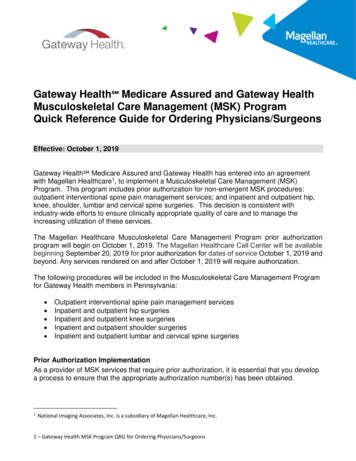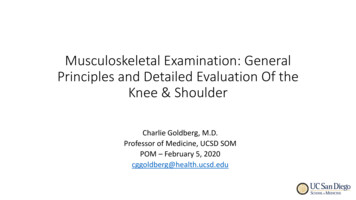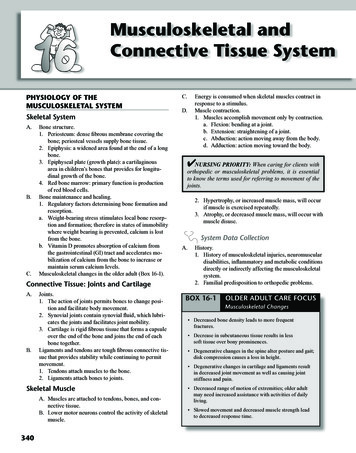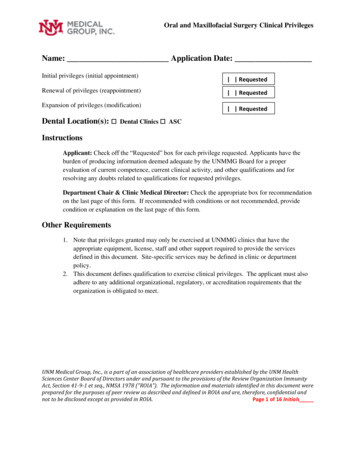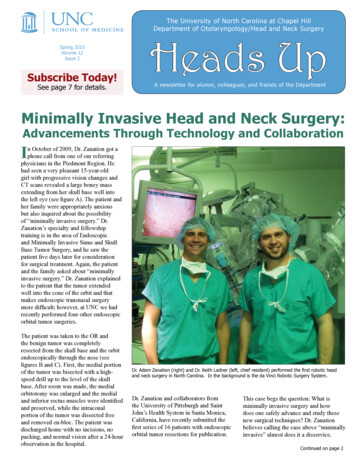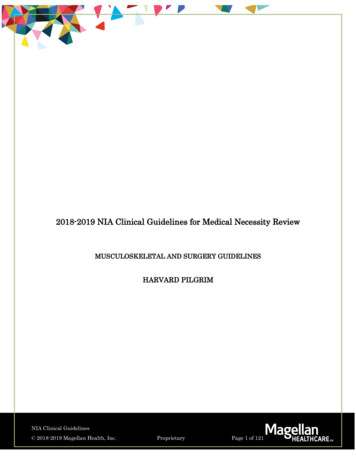
Transcription
2018-2019 NIA Clinical Guidelines for Medical Necessity ReviewMUSCULOSKELETAL AND SURGERY GUIDELINESHARVARD PILGRIMNIA Clinical Guidelines 2018-2019 Magellan Health, Inc.ProprietaryPage 1 of 121
Guidelines for Clinical Review DeterminationPreambleNIA is committed to the philosophy of supporting safe and effective treatment for patients. Themedical necessity criteria that follow are guidelines for the provision of diagnostic imaging.These criteria are designed to guide both providers and reviewers to the most appropriatediagnostic tests based on a patient’s unique circumstances. In all cases, clinical judgmentconsistent with the standards of good medical practice will be used when applying theguidelines. Guideline determinations are made based on the information provided at thetime of the request. It is expected that medical necessity decisions may change as newinformation is provided or based on unique aspects of the patient’s condition. The treatingclinician has final authority and responsibility for treatment decisions regarding the care ofthe patient.Guideline Development ProcessThese medical necessity criteria were developed by NIA for the purpose of making clinical reviewdeterminations for requests for diagnostic tests. The developers of the criteria sets includedrepresentatives from the disciplines of radiology, internal medicine, nursing, andcardiology. They were developed following a literature search pertaining to establishedclinical guidelines and accepted diagnostic imaging practices.All inquiries should be directed to:National Imaging Associates, Inc.6950 Columbia Gateway DriveColumbia, MD 21046Attn: NIA Associate Chief Medical OfficerNIA Clinical Guidelines 2018-2019 Magellan Health, Inc.ProprietaryPage 2 of 121
TABLE OF CONTENTSTOCMUSCULOSKELETAL & SURGERY GUIDELINES 422600/63001 – Cervical Spinal Surgery 422612/63030 – Lumbar Spinal Surgery 1162310-62311 – Spinal Epidural Injections 2264490-64493 – Paravertebral Facet Joint Injections/Blocks 2964633-64635 – Paravertebral Facet Joint Neurolysis 3427096 – Sacroiliac Joint Injections 3927132 – Hip Arthroplasty 4727130 – Hip Arthroscopy 5527446 – Knee Arthroplasty 6527332 – Knee Arthroscopy 7523474 – Shoulder Arthroplasty 9723415 – Shoulder Arthroscopy 10522532 – Thoracic Spine Surgery 118.NIA Clinical Guidelines 2018-2019 Magellan Health, Inc.ProprietaryPage 3 of 121
TOCMUSCULOSKELETAL & SURGERY GUIDELINES22600/63001 – Cervical Spinal SurgeryCPT Codes:Cervical Artificial Disc – Single Level 22856, 22861, 22864Cervical Artificial Disc – Two Levels (**0375T is not a covered service and is not reimbursable)22858, 0098T, 0095TOVERVIEW:This guideline outlines the key surgical treatments and indications for common cervical spinaldisorders and is a consensus document based upon the best available evidence. Spine surgery is acomplex area of medicine, and this document breaks out the clinical indications by surgical type.Operative treatment is indicated only when the natural history of an operatively treatable problemis better than the natural history of the problem without operative treatment. Choice of surgicalapproach is based on anatomy, the patient's pathology, and the surgeon's experience andpreference. All operative interventions must be based on a positive correlation with clinicalfindings, the natural history of the disease, the clinical course, and diagnostic tests or imagingresults.Initial Clinical Reviewers (ICRs) and Physician Clinical Reviewers (PCRs) must be able to applycriteria based on individual needs and based on an assessment of the local delivery system.INDICATIONS FOR CERVICAL SPINE SURGERY:I. Cervical Artificial Disc Replacement (Single or Two Level)This involves the insertion of a prosthetic device into the cervical intervertebral space with the goalof maintaining physiologic motion at the treated cervical segment. The use of artificial discs inmotion-preserving technology is based on the surgeon's preference and training. Only FDAapproved artificial discs are appropriate.1) Indications for artificial cervical disc replacement are as follows:a) Skeletally mature patient; ANDb) Patient has intractable radiculopathy caused by one or two level disease (either herniateddisc or spondolytic osteophyte) located at C3-C7; ANDc) Persistent or recurrent symptoms/pain with functional limitations that are unresponsive toat least 6 weeks of appropriate conservative treatment. Documented failure of at least 6consecutive weeks of any 2 of the following physician-directed conservative treatments:i) Analgesics, steroids, and/or NSAIDsNIA Clinical Guidelines 2018-2019 Magellan Health, Inc.ProprietaryPage 4 of 121
ii)Structured program of physical therapyiii) Structured home exercise program prescribed by a physical therapist, chiropracticprovider or physicianiv)Epidural steroid injections and or facet injections /selective nerve root block; ANDd) Imaging studies confirm the presence of compression at the level(s) corresponding with theclinical findings (MRI or CT); ANDe) No prior neck surgery; ANDf) Use of an FDA-approved prosthetic intervertebral discs2) Cervical Artificial Disc Replacement is NOT indicated when any of the following clinicalscenarios exists:a)b)c)d)e)f)g)h)i)j)k)l)m)II.Symptomatic multiple level disease affecting 3 or more levelsAdjacent level disease: degenerative disease adjacent to a previous cervical fusionInfection (at site of implantation or systemic)Osteoporosis or osteopeniaInstabilityi) Translation greater than 3mm difference between lateral flexion- extension views at thesymptomatic levels;ii) 11 degrees of angular difference between lateral flexion-extension views at thesymptomatic levelsSensitivity or allergy to implant materialsSevere spondylosis defined as:i) 50% disc height loss compared to minimally or non-degenerated levels; ORii) Bridging osteophytes: ORiii) Absence of motion on lateral flexion-extension views at the symptomatic siteSevere facet arthropathyAnkylosing spondylitisRheumatoid arthritisPrevious fracture with anatomical deformityOssification of the posterior longitudinal ligament (OPLL)Active cervical spine malignancyADDITIONAL INFORMATION:1) CPT Codes:a) Cervical Artificial Disc – Single Level 22856, 22861, 22864b) Cervical Artificial Disc – Two Levels (**0375T is not a covered service and is notreimbursable) 22858, 0098T, 0095T2) *Conservative Therapy: (Musculoskeletal) includes primarily physical therapy and /or injections;and a combination of modalities, such as rest, ice, heat, modified activities, medical devices, (suchas crutches, immobilizer, metal braces, orthotics, rigid stabilizer or splints, etc and not to includeNIA Clinical Guidelines 2018-2019 Magellan Health, Inc.ProprietaryPage 5 of 121
neoprene sleeves), medications, diathermy, chiropractic treatments, or physician supervised homeexercise program. Part of this combination may include the physician instructing patient to rest thearea or stay off the injured part.3) **Home Exercise Program - (HEP) – the following two elements are required to meet guidelinesfor completion of conservative therapy:a) Information provided on exercise prescription/plan ANDb) Follow up with member with documentation provided regarding completion of HEP, (after 4– 6 week period) or inability to complete HEP due to physical reason- i.e. increased pain,inability to physically perform exercises. (Patient inconvenience or noncompliance withoutexplanation does not constitute “inability to complete” HEP).4) A comprehensive assimilation of factors should lead to a specific diagnosis with positiveidentification of the pathologic condition(s).a) Early intervention may be required in acute incapacitating pain or in the presence ofprogressive neurological deficits.b) Operative treatment is indicated when the natural history of surgically treated lesions isbetter than the natural history for non-operatively treated lesions.c) Patients may present with localized pain or severe pain in combination with numbness,extremity weakness, loss of coordination, gait issues, or bowel and bladder complaints.Nonoperative treatment continues to play an important role in the care of patients withdegenerative cervical spine disorders. If these symptoms progress to neurological deficits,from corresponding spinal cord or nerve root compression, than surgical intervention may bewarranted.d) All patients being considered for surgical intervention should first undergo a comprehensiveneuromusculoskeletal examination to identify those pain generators that may either respondto non-surgical techniques, or may be refractory to surgical intervention.e) If operative intervention is being considered, particularly those procedures that require afusion, it is recommended that the person refrain from smoking for at least six weeks priorto surgery and during the time of healing.f) In situations requiring the possible need for operation, a second opinion may be necessary.Psychological evaluation is strongly encouraged when surgery is being performed for isolatedaxial pain to determine if the patient will likely benefit from the treatment.g) It is imperative for the clinician to rule out non-physiologic modifiers of pain presentation, ornon-operative conditions mimicking radiculopathy, myelopathy or spinal instability(peripheral compressive neuropathy, chronic soft tissue injuries, and psychologicalconditions), prior to consideration of elective surgical intervention.5) Degenerative cervical spine disorders, while often benign and episodic in nature, can becomedebilitating, resulting in axial pain and neurological damage to the spinal cord or roots.Compression on the nerve root and / or spinal cord may be caused by (1) a herniated disc with orwithout extrusion of disc fragments and/or (2) degenerative cervical spondylosis.NIA Clinical Guidelines 2018-2019 Magellan Health, Inc.ProprietaryPage 6 of 121
III. REFERENCES1) American Academy of Orthopaedic Surgeons (AAOS). Cervical Spondylotic Myelopathy: SurgicalTreatment Options. Reviewed November 2009. Available at:http://orthoinfo.aaos.org/topic.cfm?topic A00539. Accessed August 26, 2013.2) Bartels RH, van Tulder MW, Moojen WA, Arts MP, Peul WC. Laminoplasty and laminectomyfor cervical sponydylotic myelopathy: a systematic review. Eur Spine J. 2013. Epub ahead ofprint. April 11, 2013. Available at: 013-2771z. Accessed August 26, 2013.3) Bono CM, Ghiselli G, Gilbert TJ, et al. An evidence-based clinical guideline for the diagnosisand treatment of cervical radiculopathy from degenerative disorders. Spine J. 2011;11(1):64-72.doi: 10.1016/j.spinee.2010.10.023.4) Botelho RV, Dos Santos Buscariolli Y, de Barros Vasconcelos Fernandes Serra MV, Bellini MN,Bernardo WM. The choice of the best surgery after single level anterior cervical spinediscectomy: a systematic review. Open Orthop J. 2012;6:121-128.5) Cheng L, Nie L, Zhang L, Hou Y. Fusion versus Bryan Cervical Disc in two-level cervical discdisease: a prospective, randomised study. Int Orthop. 2009 Oct;33(5):1347-51. doi:10.1007/s00264-008-0655-3. Epub 2008 Oct 28.6) Cunningham MR, Hershman S, Bendo J. Systematic review of cohort studies comparingsurgical treatments for cervical spondylotic myelopathy. Spine (Phila Pa 1976). 2010;35(5):537543.7) Davis RJ, Nunley PD, Kim KD, Hisey MS, Jackson RJ, Bae HW, Hoffman GA, Gaede SE,Danielson GO 3rd, Gordon C, Stone MB. Two-level total disc replacement with Mobi-C cervicalartificial disc versus anterior discectomy and fusion: a prospective, randomized, controlledmulticenter clinical trial with 4-year follow-up results. J Neurosurg Spine. 2015 Jan;22(1):15-25.doi: 10.3171/2014.7.SPINE13953.8) Gebremariam L, Koes BW, Peul WC, Huisstede BM. Evaluation of treatment effectiveness forthe herniated cervical disc: a systematic review. Spine (Phila Pa 1976). 2012;37(2):E109-E118.9) Heary RF, Ryken TC, Matz PG, et al.; Joint Section on Disorders of the Spine and PeripheralNerves of the American Association of Neurological Surgeons and Congress of NeurologicalSurgeons. Cervical laminoforaminotomy for the treatment of cervical degenerativeradiculopathy. J Neurosurg Spine. 2009;11(2):198-202.10) Holly LT, Matz PG, Anderson PA, et al.; Joint Section on Disorders of the Spine and PeripheralNerves of the American Association of Neurological Surgeons and Congress of NeurologicalSurgeons. Clinical prognostic indicators of surgical outcome in cervical spondylotic myelopathy.J Neurosurg Spine. 2009;11(2):112-118.11) Kwon BK, Hilibrand AS, Malloy, K; Savas PE, et al.; A critical Analysis of the LiteratureRegarding Surgical Approach and Outcome for Adult Low-Grade Isthmic Spondylolisthesis. JSpinal Disord Tech. 2005;18(1): S30-40. http://www.ncbi.nlm.nih.gov/pubmed/1569980312) Matsunaga S, Komiya S, Toyama Y. Risk factors for development of myelopathy in patientswith cervical spondylotic cord compression. Eur Spine J. 2013. Epub ahead of print. May 23,NIA Clinical Guidelines 2018-2019 Magellan Health, Inc.ProprietaryPage 7 of 121
2013. Available at: 013-2839-9. AccessedAugust 26, 2013.13) Matz PG, Anderson PA, Groff MW, et al.; Joint Section on Disorders of the Spine and PeripheralNerves of the American Association of Neurological Surgeons and Congress of NeurologicalSurgeons. Cervical laminoplasty for the treatment of cervical degenerative myelopathy. JNeurosurg Spine. 2009c;11(2):157-169.14) Matz PG, Anderson PA, Holly LT, et al.; Joint Section on Disorders of the Spine and PeripheralNerves of the American Association of Neurological Surgeons and Congress of NeurologicalSurgeons. The natural history of cervical spondylotic myelopathy. J Neurosurg Spine.2009d;11(2):104-111.15) Matz PG, Holly LT, Groff MW, et al.; Joint Section on Disorders of the Spine and PeripheralNerves of the American Association of Neurological Surgeons and Congress of NeurologicalSurgeons. Indications for anterior cervical decompression for the treatment of cervicaldegenerative radiculopathy. J Neurosurg Spine. 2009a;11(2):174-182.16) Matz PG, Holly LT, Mummaneni PV, et al.; Joint Section on Disorders of the Spine andPeripheral Nerves of the American Association of Neurological Surgeons and Congress ofNeurological Surgeons. Anterior cervical surgery for the treatment of cervical degenerativemyelopathy. J Neurosurg Spine. 2009b;11(2):170-173.17) Matz PG, Meagher RJ, Lamer T, et al.; Diagnosis and Treatment of Degenerative LumbarSpondylolisthesis 2nd Edition. North American Spine Society. 2014. icalCare/Guidelines/Spondylolisthesis.pdf18) Matz PG, Ryken TC, Groff MW, et al.; Joint Section on Disorders of the Spine and PeripheralNerves of the American Association of Neurological Surgeons and Congress of NeurologicalSurgeons. Techniques for anterior cervical decompression for radiculopathy. J Neurosurg Spine.2009e;11(2):183-197.19) Mummaneni PV, Kaiser MG, Matz PG, et al.; Joint Section on Disorders of the Spine andPeripheral Nerves of the American Association of Neurological Surgeons and Congress ofNeurological Surgeons. Cervical surgical techniques for the treatment of cervical spondyloticmyelopathy. J Neurosurg Spine. 2009;11(2):130-141.20) Nikolaidis I, Fouyas IP, Sandercock PA, Statham PF. Surgery for cervical radiculopathy ormyelopathy. Cochrane Database Syst Rev. 2010;(1):CD001466.21) Patel RA, Wilson FR, Patel PA, Palmer RM., The effect of smoking on bone healing, Asystematic Review. Bone Joint Res. d/2383647422) Ryken TC, Heary RF, Matz PG, et al.; Joint Section on Disorders of the Spine and PeripheralNerves of the American Association of Neurological Surgeons and Congress of NeurologicalSurgeons. Cervical laminectomy for the treatment of cervical degenerative myelopathy. JNeurosurg Spine. 2009;11(2):142-149.23) Tetreault LA, Karpova A, Fehlings MG. Predictors of outcome in patients with degenerativecervical spondylotic myelopathy undergoing surgical: results of a systematic review. Eur SpineNIA Clinical Guidelines 2018-2019 Magellan Health, Inc.ProprietaryPage 8 of 121
J. 2013. Epub ahead of print. February 6, 2013. Available 86-013-2658-z. Accessed August 26, 2013.24) van Middelkoop M, Rubinstein SM, Ostelo R, et al. No additional value of fusion techniques onanterior discectomy for neck pain: a systematic review. Pain. 2012;153(11):2167-2173.25) Wang SJ, Jiang SD, Jiang LS, Dai LY. Axial pain after posterior cervical spine surgery: asystematic review. Eur Spine J. 2011;20(2):185-194.26) Wang TY, Lubelski D, Abdullah KG, et al. Rates of anterior cervical discectomy and fusion afterinitial posterior cervical foraminotomy. Spine J. 2013. Epub ahead of print. July 16, 2013.Available at: -9430(13)00558-5/abstract .Accessed August 26, 2013.27) Woods BI, Hohl J, Lee J, Donaldson W 3rd, Kang J. Laminoplasty versus laminectomy andfusion for multilevel cervical spondylotic myelopathy. Clin Orthop Relat Res. 2011;469(3):688695.28) Yalamanchili PK, Vives MJ, Chaudhary SB. Cervical spondylotic myelopathy: factors inchoosing the surgical approach. Adv Orthop. 2012;2012:783762.29) Zhu B, Xu Y, Liu X, et al. Anterior approach versus posterior approach for the treatment ofmultilevel cervical spondylotic myelopathy: a systemic review and meta-analysis. Eur Spine J.2013;22(7):1583-1593.XIV. Fusion References1) American Academy of Orthopaedic Surgeons (AAOS). (2009). Cervical Spondylotic Myelopathy:Surgical Treatment Options. Retrieved from http://orthoinfo.aaos.org/topic.cfm?topic A00539.2) Anderson, P.A., Matz, P.G., Groff, M.W., Heary, R.F., Holly, L.T., Kaiser, M.G., Resnick,D.K., Joint Section on Disorders of the Spine and Peripheral Nerves [trunc]. (2007).Laminectomy and fusion for the treatment of cervical degenerative myelopathy. NeurosurgSpine, 11, 150-6. Retrieved fromhttp://www.guideline.gov/content.aspx?id 24481&search posterior cervical laminectomy.3) Matz, P.G., Holly, L.T., Groff, M.W., Vresilovic, E.J., Anderson, P.A., Heary, R.F., JointSection on Disorders of the Spine and Peripheral Nerves [trunc]. (2009). Indications for anteriorcervical decompression for the treatment of cervical degenerative radiculopathy. J NeurosurgSpine, 11, 174-82. Retrieved from: http://www.guideline.gov/content.aspx?id 24484. August 22,2013.4) Resnick DK, Choudhri TF, Dailey AT, et al.; Guidelines for the performance of fusion proceduresfor degenerative disease of the lumbar spine. Part 7: intractable low-back pain without stenosisor spondylolisthesis. J Neurosurg: Spine. 2005; 355) van Middelkoop, M., Rubinstein, S.M., Ostelo, R., van Tulder, MW., Peul, W., Koes, BW.,Verhagen AP. (2012). No additional value of fusion techniques on anterior discectomy for neckpain: a systematic review. Pain, 153, 2167-73. doi: 10.1016/j.pain.2012.04.021. Epub 2012 Jul18.NIA Clinical Guidelines 2018-2019 Magellan Health, Inc.ProprietaryPage 9 of 121
6) Zhu, B., Xu, Y., Liu, X., Liu, Z., & Dang, G. (2013). Anterior approach versus posterior approachfor the treatment of multilevel cervical spondylotic myelopathy: a systemic review and metaanalysis. Eur Spine J., 22, 1583-93. doi: 10.1007/s00586-013-2817-2. Epub 2013 May 9.NIA Clinical Guidelines 2018-2019 Magellan Health, Inc.ProprietaryPage 10 of 121
TOC22612/63030 – Lumbar Spinal SurgeryCPT Codes:-Lumbar Fusion (Single level) 22533, 22558, 22612, 22630, 22633 Plus Decompression-Lumbar Fusion (Multiple levels) 22533, 22534, 22558, 22585, 22612, 22614, 22630, 22632, 22633, 22634 ( indicates multiple levels) Plus Decompression-Lumbar Decompression 63030, 63035, 63005, 63012, 63017, 63042, 63044, 63047, 63048, 63056, 63057-Lumbar Discectomy/Microdiscectomy 63030, 63035, 62380OVERVIEW:This guideline outlines the key surgical treatments and indications for common lumbar spinaldisorders and is a consensus document based upon the best available evidence. Spine surgery is acomplex area of medicine and this document breaks out the treatment modalities for lumbar spinedisorders into surgical categories: lumbar discectomy/microdiscectomy, lumbar decompression, andlumbar fusion surgery. See the additional information section for procedures considered notmedically necessary.Initial Clinical Reviewers (ICRs) and Physician Clinical Reviewers (PCRs) must be able to applycriteria based on individual needs and based on an assessment of the local delivery system.INTRODUCTIONI.II.III.Lumbar Discectomy/Microdiscectomy is a surgical procedure to remove part of the damagedspinal disc. The damaged spinal disc herniates into the spinal canal and compresses thenerve roots. Nerve root compression leads to symptoms like low back pain, radicular pain,numbness and tingling, muscular weakness, and paresthesia. Typical disc herniation pain isexacerbated with any movement that causes the disc to increase pressure on the nerve roots.Lumbar Decompression (Laminectomy, Laminotomy, Facetectomy, and Foraminotomy):Laminectomy is common decompression surgery. The American Association of NeurologicalSurgeons defines laminectomy as a surgery to remove the back part of vertebra, lamina, tocreate more space for the spinal cord and nerves. The most common indication forlaminectomy is spinal stenosis. Spondylolisthesis and herniated disk are also frequentindications for laminectomy. Decompression surgery is usually performed as part of lumbarfusion surgery.Lumbar Fusion Surgery: Lumbar spinal fusion (arthrodesis) is a surgical procedure used totreat spinal conditions of the lumbar, e.g., degenerative disc disease, spinal stenosis,injuries/fractures of the spine, spinal instability, and spondylolisthesis. Spinal fusion is a“welding” process that permanently fuses or joins together two or more adjacent bones in thespine, immobilizing the vertebrae and restricting motion at a painful joint. It is usuallyNIA Clinical Guidelines 2018-2019 Magellan Health, Inc.ProprietaryPage 11 of 121
performed after other surgical procedures of the spine, such as discectomy or laminectomy.The goal of fusion is to increase spinal stability, reduce irritation of the affected nerve roots,compression on the spinal cord, disability, and pain and/or numbness. Clinical criteria forsingle level fusion versus multiple level fusions are outlined under the indications section.I.INDICATIONS FOR LUMBAR & PRE-SACRAL SURGERY: (This section of the clinicalguidelines provides the clinical criteria for each of the lumbar and pre-sacral spine surgerycategories.)1) Indications for Lumbar Discectomy/Microdiscectomy - Surgical indications for intervertebral disc herniation*:a) Primary radicular symptoms noted upon clinical exam that significantly hindersdaily activities; ANDb) Failure to improve with at least six (6) consecutive weeks of appropriate conservativetreatment; And Documented failure of at least six (6) consecutive weeks of any 2 ofthe following physician-directed conservative treatments:i)Analgesics, steroids, and/or NSAIDsii)Structured program of physical therapyiii) Structured home exercise programprescribed by a physical therapist,chiropractic provider or physicianiv) Epidural steroid injections and or facet injections /selective nerve root block;ANDc) Imaging studies showing evidence of inter-vertebral disc herniation that correlateexactly with the patients symptoms / signs2) *Other indications: Microdiscectomy may be used as the first line of treatment (noconservative treatment required) in the following clinical scenarios:a) Progressive nerve compression resulting in an acute motor neurologic deficit sensoryor motor due to herniated disc. The neurological deficits should be significant: 0-2/5on the motor function scale for L5 or S1 roots; 0-3/5 for L3 or L4 roots. Lesserdegrees of motor dysfunction may resolve with conservative treatment and are notconsidered an indication for early surgery; ORb) Cauda equina syndrome (loss of bowel or bladder control).NOTE: Percutaneous lumbar discectomy, radiofrequency disc decompression, and relatedprocedures are deemed investigational procedures and are not approved. Discectomy andmicrodiscectomy are the gold standards.II.Indications for Lumbar Decompression: Laminectomy, Laminotomy, Facetectomy, andForaminotomy. These procedures allow decompression by partial or total removal of variousparts of vertebral bone and ligaments. Surgical Indications for spinal canal decompressiondue to lumbar spinal stenosis*:1) Neurogenic claudication, and/or radicular leg pain that impairs daily activities for atleast twelve (12) weeks; ANDNIA Clinical Guidelines 2018-2019 Magellan Health, Inc.ProprietaryPage 12 of 121
2) Failure to improve with at least 6 weeks of appropriate conservative therapy.Documented failure of at least 6 consecutive weeks of any 2 of the following physiciandirected conservative treatments:a) Analgesics, steroids, and/or NSAIDsb) Structured program of physical therapyc) Structured home exercise program prescribed by a physical therapist, chiropracticprovider or physiciand) Epidural steroid injections and or facet injections /selective nerve root block; AND3) Imaging findings demonstrating moderate to severe stenosis consistent with clinicalsigns/symptoms.4) *Other Indications: Lumbar decompression may be used as the first line of treatment(no conservative treatment required) in any of the following clinical scenarios:a) Progressive nerve compression resulting in an acute neurologic (sensory or motor) deficit.The neurological deficits should be significant—0-2/5 on the motor function scale for L5or S1 roots; 0-3/5 for L3 or L4 roots. Lesser degrees of motor dysfunction may resolvewith conservative treatment and are not considered an indication for early surgery.b) Cauda equina syndrome (loss of bowel or bladder control)c) Spinal stenosis due to tumor, infection, or traumaNOTE: Percutaneous decompressions, endoscopic decompression, and related procedures(laser, etc.) are deemed investigational procedures and are not approved. Open ormicrodecompressions via laminectomy or laminotomy are the gold standards.III.Indications for Lumbar Spine Fusion: Single Level with or without decompressioni) Because of variable outcomes with fusion surgery, patients should be actively involved inthe decision-making process and provided appropriate decision-support materials whenconsidering this intervention. The following indicators must be present*:a) Lumbar back pain, neurogenic claudication, and/or radicular leg pain without sensoryor motor deficit that impairs daily activities for at least 6 months; ANDb) Failure to improve with at least 6 weeks of appropriate conservative therapy (sixmonths for isolated LBP). Documented failure of at least 6 consecutive weeks of any 2of the following physician-directed conservative treatments:i)Analgesics, steroids, and/or NSAIDsii)Structured program of physical therapyiii) Structured home exercise program prescribed by a physical therapist,chiropractic provider or physicianiv) Epidural steroid injections and or facet injections /selective nerve root block;ANDc) Imaging studies corresponding to the clinical findings; ANDd) At least one of the following clinical conditions:i)Spondylolisthesis [Neural Arch Defect -Spondylolytic spondylolisthesis,degenerative spondylolisthesis, and congenital unilateral neural archhypoplasia]; ORii)Evidence of segmental instability -Excessive motion, as in degenerativespondylolisthesis, segmental instability, and surgically induced segmentalinstability; ORNIA Clinical Guidelines 2018-2019 Magellan Health, Inc.ProprietaryPage 13 of 121
iii)iv)v)vi)Revision surgery for failed previous operation(s) for pseudoarthorsis at thesame level at least 6-12 months from prior surgery** if significant functionalgains are anticipated; ORRevision surgery for failed previous operation(s) repeat disk herniations ifsignificant functional gains are anticipated (Note: Many recurrent discherniations can be treated with discectomy alone, so specific indications for theaddition of fusion will be required); ORFusion for the treatment of spinal tumor, cancer, or infection; ORChronic low back pain or degenerative disc disease (disc degeneration withoutsignificant neurological compression presenting with low back pain) must havefailed at least 6 months of appropriate active non-operative treatment(completion of a comprehensive cognitive -behavioral rehabilitation program ismandatory) and must be evaluated on a case-by-case basis.NOTE: The results of several randomized trials suggests that in many degenerative casesuninstrumented posterolateral intertransverse fusion has similar results to largerinstrumented (PLIF, TLIF, etc.) fusion techniques with fewer morbidities and less likelihoodof revision surgery. Accordingly, specific findings suggesting more significant instabilityshould be present when larger techniques are used (gaping of facets, gross motion on flexion/ extension radiographs, wide disc spaces).2) *Other Indications: Lumbar spinal fusion may be used as the first line of treatment (noconservative treatm
Cervical Artificial Disc - Single Level 22856, 22861, 22864 Cervical Artificial Disc - Two Levels (**0375T is not a covered service and is not reimbursable) . Hou Y. Fusion versus Bryan Cervical Disc in two-level cervical disc disease: a prospective, randomised study. Int Orthop. 2009 Oct;33(5):1347-51. doi: 10.1007/s00264-008-0655-3 .



